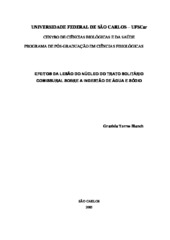Efeitos da lesão do núcleo do trato solitário comissural sobre a ingestão de água e sólido
Abstract
The central nervous system (CNS) has an important function in the regulation of
homeostatic mechanisms controlling the volemia and osmolality of the body fluid. The
nucleus of the tract solitary (NTS) is the primary site of the cardiovascular afferents and
peripheral osmoreceptors. From to NTS, the information about arterial blood pressure,
extracellular fluid composition and volume goes to other areas into the CNS involved to
cardiovascular regulation and hydroeletrolytic balance, e.g., anteroventral third ventricle
region (AV3V), paraventricular nucleus of hypothalamus, lateral parabrachial nucleus
(LPBN) and the vasomotors nuclei of medulla. The NTS can be anatomically divided in
rostral NTS, intermediate NTS and commissural NTS (commNTS). Therefore, the aims of
this study were: a) to study the effects of acute and chronic electrolytic lesion of the commNTS
on the water and 0.3 M NaCl intake induced by different protocols that induced intracellular
and/or extracellular dehydration, b) to study the possible mechanisms which commNTS lesion
induce changes in water and/or sodium intake, evaluating the hemodynamic and renal changes.
Male Holtzman rats (300-320g) were submitted to commNTS or sham lesion. The
animals were anesthetized and placed in a stereotaxic apparatus. Through a partial craniotomy
of the occipital bone, the dura mater and arachnoid were incised, and the dorsal surface of the
brain stem was exposed. Electrolytic lesions were performed with a tungsten electrode
inserted into the brain stem following coordinates: 0.0 mm lateral, 0.4, 0.7 and 1.0 mm
posterior to the calamus scriptorius, and 0.1 mm below the dorsal surface of the brain. The
electrolytic lesions were performed with 1 mA current delivered for 5 seconds, twice with a
30 s interval between them. Sham-operated rats underwent the same procedures, but no
current was passed.
Initial body weight was the same, but commNTS lesioned rats had a significant loss in
the weight compared with sham rats during the 14 days. The pressor response of the
chemoreflex, tested with potassium cyanide iv, was reduced in chronic commNTS lesioned
rats, whereas the baroreflex tested with phenylephrine and sodium nitroprusside was
unchanged in commNTS lesioned rats.
The water intake induced by intragastric (ig) gavage of 2 M NaCl was greater in acute
and chronically commNTS-lesioned rats compared to sham rats. There was no 0.3 M NaCl
intake after ig gavage of 2 M NaCl in lesioned or sham rats. Acute and chronically, the
treatment with furosemide (diuretic) and captopril (ANG II converting enzyme inhibitor)
